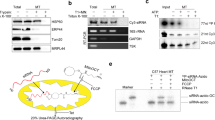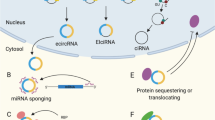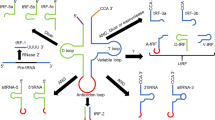Abstract
RNA interference is an endogenous gene-silencing mechanism that involves double-stranded RNA-mediated sequence-specific mRNA degradation. The discovery of this pathway together with the elucidation of the structure and function of short interfering RNAs — the effector molecules of RNA interference — has had an enormous impact on experimental biology. RNA interference technologies are currently the most widely utilized techniques in functional genomic studies. Furthermore, there is an intense research effort aimed at developing short interfering RNAs for therapeutic purposes. A number of proof-of-principle experiments have demonstrated the clinical potential of appropriately designed short interfering RNAs in various diseases including viral infections, cancer and neurodegenerative disorders. Already, in such a short time from their discovery, Acuity Pharmaceuticals (August 2004) and Sirna Therapeutics (September 2004) have filed Investigational New Drug applications with the US FDA to begin clinical trials with modified siRNA molecules in patients with age-related macular degeneration. This review will give a brief overview of the mechanism of RNA interference and applications of the pathway in experimental biology will be discussed. The article will focus on recent developments related to the use of RNA interference technologies in mammalian systems and on potential clinical applications of short interfering RNA-mediated RNA interference.
This is a preview of subscription content, access via your institution
Access options
Subscribe to this journal
Receive 12 print issues and online access
$259.00 per year
only $21.58 per issue
Buy this article
- Purchase on Springer Link
- Instant access to full article PDF
Prices may be subject to local taxes which are calculated during checkout
Similar content being viewed by others
References
Fire A, Xu S, Montgomery MK, Kostas SA, Driver SE, Mello CC . Potent and specific genetic interference by double-stranded RNA in Caenorhabditis elegans. Nature. 1998;391:806–811.
Napoli C, Lemieux C, Jorgensen R . Introduction of a chimeric chalcone synthase gene into petunia results in reversible co-suppression of homologous genes in trans. Plant Cell. 1990;2:279–289.
Jorgensen RA, Cluster PD, English J, Que Q, Napoli CA . Chalcone synthase cosuppression phenotypes in petunia flowers: comparison of sense vs. antisense constructs and single-copy vs. complex T-DNA sequences. Plant Mol Biol. 1996;31:957–973.
Cogoni C, Macino G . Post-transcriptional gene silencing across kingdoms. Curr Opin Genet Dev. 2000;10:638–643.
Gura T . A silence that speaks volumes. Nature. 2000;404:804–808.
Hammond SM, Caudy AA, Hannon GJ . Post-transcriptional gene silencing by double-stranded RNA. Nat Rev Genet. 2001;2:110–119.
Guo S, Kemphues KJ . par-1, a gene required for establishing polarity in C. elegans embryos, encodes a putative Ser/Thr kinase that is asymmetrically distributed. Cell. 1995;81:611–620.
Elbashir SM, Martinez J, Patkaniowska A, Lendeckel W, Tuschl T . Functional anatomy of siRNAs for mediating efficient RNAi in Drosophila melanogaster embryo lysate. EMBO J. 2001;20:6877–6888.
Dorsett Y, Tuschl T . siRNAs: applications in functional genomics and potential as therapeutics. Nat Rev Drug Discov. 2004;3:318–329.
Bernstein E, Caudy AA, Hammond SM, Hannon GJ . Role for a bidentate ribonuclease in the initiation step of RNA interference. Nature. 2001;409:363–366.
Zamore PD . Ancient pathways programmed by small RNAs. Science. 2002;296:1265–1269.
Dillin A . The specifics of small interfering RNA specificity. Proc Natl Acad Sci USA. 2003;100:6289–6291.
Novina CD, Sharp PA . The RNAi revolution. Nature. 2004;430:161–164.
Lee Y, Jeon K, Lee JT, Kim S, Kim VN . MicroRNA maturation: stepwise processing and subcellular localization. EMBO J. 2002;21:4663–4670.
Olsen PH, Ambros V . The lin-4 regulatory RNA controls developmental timing in Caenorhabditis elegans by blocking LIN-14 protein synthesis after the initiation of translation. Dev Biol. 1999;216:671–680.
Wightman B, Ha I, Ruvkun G . Posttranscriptional regulation of the heterochronic gene lin-14 by lin-4 mediates temporal pattern formation in C. elegans. Cell. 1993;75:855–862.
Nelson PT, Hatzigeorgiou AG, Mourelatos Z . miRNP: mRNA association in polyribosomes in a human neuronal cell line. RNA. 2004;10:387–394.
Kim J, Krichevsky A, Grad Y, et al. Identification of many microRNAs that copurify with polyribosomes in mammalian neurons. Proc Natl Acad Sci USA. 2004;101:360–365.
Hutvagner G, Zamore PD . A microRNA in a multiple-turnover RNAi enzyme complex. Science. 2002;297:2056–2060.
Grishok A, Pasquinelli AE, Conte D, et al. Genes and mechanisms related to RNA interference regulate expression of the small temporal RNAs that control C. elegans developmental timing. Cell. 2001;106:23–34.
Carrington JC, Ambros V . Role of microRNAs in plant and animal development. Science. 2003;301:336–338.
Bartel DP . MicroRNAs: genomics, biogenesis, mechanism, and function. Cell. 2004;116:281–297.
Voinnet O . RNA silencing as a plant immune system against viruses. Trends Genet. 2001;17:449–459.
Li H, Li WX, Ding SW . Induction and suppression of RNA silencing by an animal virus. Science. 2002;296:1319–1321.
Tabara H, Sarkissian M, Kelly WG, et al. The rde-1 gene, RNA interference, and transposon silencing in C. elegans. Cell. 1999;99:123–132.
Verdel A, Jia S, Gerber S, et al. RNAi-mediated targeting of heterochromatin by the RITS complex. Science. 2004; 303:672–676.
Kamath RS, Fraser AG, Dong Y, et al. Systematic functional analysis of the Caenorhabditis elegans genome using RNAi. Nature. 2003;421:231–237.
Ashrafi K, Chang FY, Watts JL, et al. Genome-wide RNAi analysis of Caenorhabditis elegans fat regulatory genes. Nature. 2003;421:268–272.
Maeda I, Kohara Y, Yamamoto M, Sugimoto A . Large-scale analysis of gene function in Caenorhabditis elegans by high-throughput RNAi. Curr Biol. 2001;11:171–176.
Simmer F, Moorman C, van der Linden AM, et al. Genome-wide RNAi of C. elegans using the hypersensitive rrf-3 strain reveals novel gene functions. PLoS Biol. 2003;1:E12.
Vastenhouw NL, Fischer SE, Robert VJ, et al. A genome-wide screen identifies 27 genes involved in transposon silencing in C. elegans. Curr Biol. 2003;13:1311–1316.
Lum L, Yao S, Mozer B, et al. Identification of Hedgehog pathway components by RNAi in Drosophila cultured cells. Science. 2003;299:2039–2045.
Kiger AA, Baum B, Jones S, et al. A functional genomic analysis of cell morphology using RNA interference. J Biol. 2003;2:27.
Boutros M, Kiger AA, Armknecht S, et al. Genome-wide RNAi analysis of growth and viability in Drosophila cells. Science. 2004;303:832–835.
Stark GR, Kerr IM, Williams BR, Silverman RH, Schreiber RD . How cells respond to interferons. Annu Rev Biochem. 1998;67:227–264.
Elbashir SM, Harborth J, Lendeckel W, Yalcin A, Weber K, Tuschl T . Duplexes of 21-nucleotide RNAs mediate RNA interference in cultured mammalian cells. Nature. 2001;411:494–498.
Caplen NJ, Parrish S, Imani F, Fire A, Morgan RA . Specific inhibition of gene expression by small double-stranded RNAs in invertebrate and vertebrate systems. Proc Natl Acad Sci USA. 2001;98:9742–9747.
Bitko V, Barik S . Phenotypic silencing of cytoplasmic genes using sequence-specific double-stranded short interfering RNA and its application in the reverse genetics of wild type negative-strand RNA viruses. BMC Microbiol. 2001;1:34.
Sledz CA, Holko M, de Veer MJ, Silverman RH, Williams BR . Activation of the interferon system by short-interfering RNAs. Nat Cell Biol. 2003;5:834–839.
Moss EG, Taylor JM . Small-interfering RNAs in the radar of the interferon system. Nat Cell Biol. 2003;5:771–772.
Bertrand JR, Pottier M, Vekris A, Opolon P, Maksimenko A, Malvy C . Comparison of antisense oligonucleotides and siRNAs in cell culture and in vivo. Biochem Biophys Res Commun. 2002;296:1000–1004.
Clayton J . RNA interference: the silent treatment. Nature. 2004;431:599–605.
Braasch DA, Jensen S, Liu Y, et al. RNA interference in mammalian cells by chemically-modified RNA. Biochemistry. 2003;42:7967–7975.
Chiu YL, Rana TM . RNAi in human cells: basic structural and functional features of small interfering RNA. Mol Cell. 2002;10:549–561.
Hannon GJ, Rossi JJ . Unlocking the potential of the human genome with RNA interference. Nature. 2004;431:371–378.
Sioud M . Therapeutic siRNAs. Trends Pharmacol Sci. 2004;25:22–28.
Holen T, Amarzguioui M, Wiiger MT, Babaie E, Prydz H . Positional effects of short interfering RNAs targeting the human coagulation trigger Tissue Factor. Nucleic Acids Res. 2002;30:1757–1766.
Kurreck J . Antisense technologies. Improvement through novel chemical modifications. Eur J Biochem. 2003;270:1628–1644.
Brummelkamp TR, Bernards R, Agami R . A system for stable expression of short interfering RNAs in mammalian cells. Science. 2002;296:550–553.
Lee NS, Dohjima T, Bauer G, et al. Expression of small interfering RNAs targeted against HIV-1 rev transcripts in human cells. Nat Biotechnol. 2002;20:500–505.
Miyagishi M, Taira K . U6 promoter-driven siRNAs with four uridine 3' overhangs efficiently suppress targeted gene expression in mammalian cells. Nat Biotechnol. 2002;20:497–500.
Paddison PJ, Caudy AA, Bernstein E, Hannon GJ, Conklin DS . Short hairpin RNAs (shRNAs) induce sequence-specific silencing in mammalian cells. Genes Dev. 2002;16:948–958.
Paul CP, Good PD, Winer I, Engelke DR . Effective expression of small interfering RNA in human cells. Nat Biotechnol. 2002;20:505–508.
Sui G, Soohoo C, Affar el B, et al. A DNA vector-based RNAi technology to suppress gene expression in mammalian cells. Proc Natl Acad Sci USA. 2002;99:5515–5520.
Yu JY, DeRuiter SL, Turner DL . RNA interference by expression of short-interfering RNAs and hairpin RNAs in mammalian cells. Proc Natl Acad Sci USA. 2002;99:6047–6052.
Reid T, Warren R, Kirn D . Intravascular adenoviral agents in cancer patients: lessons from clinical trials. Cancer Gene Ther. 2002;9:979–986.
Hsieh AC, Bo R, Manola J, et al. A library of siRNA duplexes targeting the phosphoinositide 3-kinase pathway: determinants of gene silencing for use in cell-based screens. Nucleic Acids Res. 2004;32:893–901.
Brummelkamp TR, Nijman SM, Dirac AM, Bernards R . Loss of the cylindromatosis tumour suppressor inhibits apoptosis by activating NF-kappaB. Nature. 2003;424:797–801.
Berns K, Hijmans EM, Mullenders J, et al. A large-scale RNAi screen in human cells identifies new components of the p53 pathway. Nature. 2004;428:431–437.
Paddison PJ, Silva JM, Conklin DS, et al. A resource for large-scale RNA-interference-based screens in mammals. Nature. 2004;428:427–431.
Zheng L, Liu J, Batalov S, et al. An approach to genomewide screens of expressed small interfering RNAs in mammalian cells. Proc Natl Acad Sci USA. 2004;101:135–140.
Luo B, Heard AD, Lodish HF . Small interfering RNA production by enzymatic engineering of DNA (SPEED). Proc Natl Acad Sci USA. 2004;101:5494–5499.
Shirane D, Sugao K, Namiki S, Tanabe M, Iino M, Hirose K . Enzymatic production of RNAi libraries from cDNAs. Nat Genet. 2004;36:190–196.
Sen G, Wehrman TS, Myers JW, Blau HM . Restriction enzyme-generated siRNA (REGS) vectors and libraries. Nat Genet. 2004;36:183–189.
McCaffrey AP, Meuse L, Pham TT, Conklin DS, Hannon GJ, Kay MA . RNA interference in adult mice. Nature. 2002;418:38–39.
Matsuda T, Cepko CL . Electroporation and RNA interference in the rodent retina in vivo and in vitro. Proc Natl Acad Sci USA. 2004;101:16–22.
Layzer JM, McCaffrey AP, Tanner AK, Huang Z, Kay MA, Sullenger BA . In vivo activity of nuclease-resistant siRNAs. RNA. 2004;10:766–771.
Lewis DL, Hagstrom JE, Loomis AG, Wolff JA, Herweijer H . Efficient delivery of siRNA for inhibition of gene expression in postnatal mice. Nat Genet. 2002;32:107–108.
Sorensen DR, Leirdal M, Sioud M . Gene silencing by systemic delivery of synthetic siRNAs in adult mice. J Mol Biol. 2003;327:761–766.
Song E, Lee SK, Wang J, et al. RNA interference targeting Fas protects mice from fulminant hepatitis. Nat Med. 2003;9:347–351.
Zender L, Hutker S, Liedtke C, et al. Caspase 8 small interfering RNA prevents acute liver failure in mice. Proc Natl Acad Sci USA. 2003;100:7797–7802.
Brummelkamp TR, Bernards R, Agami R . Stable suppression of tumorigenicity by virus-mediated RNA interference. Cancer Cell. 2002;2:243–247.
Hommel JD, Sears RM, Georgescu D, Simmons DL, DiLeone RJ . Local gene knockdown in the brain using viral-mediated RNA interference. Nat Med. 2003;9:1539–1544.
Wiznerowicz M, Trono D . Conditional suppression of cellular genes: lentivirus vector-mediated drug-inducible RNA interference. J Virol. 2003;77:8957–8961.
Xia H, Mao Q, Paulson HL, Davidson BL . siRNA-mediated gene silencing in vitro and in vivo. Nat Biotechnol. 2002;20:1006–1010.
Hall J . Opinion: Unravelling the general properties of siRNAs: strength in numbers and lessons from the past. Nat Rev Genet. 2004;5:552–557.
Marwick C . First “antisense” drug will treat CMV retinitis. JAMA. 1998;280:871.
Safinya CR . Structures of lipid-DNA complexes: supramolecular assembly and gene delivery. Curr Opin Struct Biol. 2001;11:440–448.
Templeton NS . Cationic liposome-mediated gene delivery in vivo. Biosci Rep. 2002;22:283–295.
Zhang Y, Zhang YF, Bryant J, Charles A, Boado RJ, Pardridge WM . Intravenous RNA interference gene therapy targeting the human epidermal growth factor receptor prolongs survival in intracranial brain cancer. Clin Cancer Res. 2004;10:3667–3677.
Schiffelers RM, Ansari A, Xu J, et al. Cancer siRNA therapy by tumor selective delivery with ligand-targeted sterically stabilized nanoparticle. Nucleic Acids Res. 2004;32:e149.
Soutschek J, Akinc A, Bramlage B, et al. Therapeutic silencing of an endogenous gene by systemic administration of modified siRNAs. Nature. 2004;432:173–178.
McCaffrey AP, Nakai H, Pandey K, et al. Inhibition of hepatitis B virus in mice by RNA interference. Nat Biotechnol. 2003;21:639–644.
Jacque JM, Triques K, Stevenson M . Modulation of HIV-1 replication by RNA interference. Nature. 2002;418:435–438.
Coburn GA, Cullen BR . Potent and specific inhibition of human immunodeficiency virus type 1 replication by RNA interference. J Virol. 2002;76:9225–9231.
Surabhi RM, Gaynor RB . RNA interference directed against viral and cellular targets inhibits human immunodeficiency virus type 1 replication. J Virol. 2002;76:12963–12973.
Novina CD, Murray MF, Dykxhoorn DM, et al. siRNA-directed inhibition of HIV-1 infection. Nat Med. 2002;8:681–686.
Park WS, Miyano-Kurosaki N, Hayafune M, et al. Prevention of HIV-1 infection in human peripheral blood mononuclear cells by specific RNA interference. Nucleic Acids Res. 2002;30:4830–4835.
Song E, Lee SK, Dykxhoorn DM, et al. Sustained small interfering RNA-mediated human immunodeficiency virus type 1 inhibition in primary macrophages. J Virol. 2003;77:7174–7181.
Davidson BL, Paulson HL . Molecular medicine for the brain: silencing of disease genes with RNA interference. Lancet Neurol. 2004;3:145–149.
Kittler R, Buchholz F . RNA interference: gene silencing in the fast lane. Semin Cancer Biol. 2003;13:259–265.
Lu PY, Xie FY, Woodle MC . siRNA-mediated antitumorigenesis for drug target validation and therapeutics. Curr Opin Mol Ther. 2003;5:225–234.
Wall NR, Shi Y . Small RNA: can RNA interference be exploited for therapy? Lancet. 2003;362:1401–1403.
Bullock AN, Fersht AR . Rescuing the function of mutant p53. Nat Rev Cancer. 2001;1:68–76.
Wilda M, Fuchs U, Wossmann W, Borkhardt A . Killing of leukemic cells with a BCR/ABL fusion gene by RNA interference (RNAi). Oncogene. 2002;21:5716–5724.
Zhang L, Yang N, Mohamed-Hadley A, Rubin SC, Coukos G . Vector-based RNAi, a novel tool for isoform-specific knock-down of VEGF and anti-angiogenesis gene therapy of cancer. Biochem Biophys Res Commun. 2003;303:1169–1178.
Jiang M, Milner J . Bcl-2 constitutively suppresses p53-dependent apoptosis in colorectal cancer cells. Genes Dev. 2003;17:832–837.
Cioca DP, Aoki Y, Kiyosawa K . RNA interference is a functional pathway with therapeutic potential in human myeloid leukemia cell lines. Cancer Gene Ther. 2003;10:125–133.
Wohlbold L, van der Kuip H, Miething C, et al. Inhibition of bcr-abl gene expression by small interfering RNA sensitizes for imatinib mesylate (STI571). Blood. 2003;102:2236–2239.
Scherr M, Battmer K, Winkler T, Heidenreich O, Ganser A, Eder M . Specific inhibition of bcr-abl gene expression by small interfering RNA. Blood. 2003;101:1566–1569.
Tsuruo T, Naito M, Tomida A, et al. Molecular targeting therapy of cancer: drug resistance, apoptosis and survival signal. Cancer Sci. 2003;94:15–21.
Gottesman MM, Fojo T, Bates SE . Multidrug resistance in cancer: role of ATP-dependent transporters. Nat Rev Cancer. 2002;2:48–58.
Volm M . Multidrug resistance and its reversal. Anticancer Res. 1998;18:2905–2917.
Nieth C, Priebsch A, Stege A, Lage H . Modulation of the classical multidrug resistance (MDR) phenotype by RNA interference (RNAi). FEBS Lett. 2003;545:144–150.
Xu D, Kang H, Fisher M, Juliano RL . Strategies for inhibition of MDR1 gene expression. Mol Pharmacol. 2004;66:268–275.
Yague E, Higgins CF, Raguz S . Complete reversal of multidrug resistance by stable expression of small interfering RNAs targeting MDR1. Gene Therapy. 2004;11:1170–1174.
Peng Z, Xiao Z, Wang Y, et al. Reversal of P-glycoprotein-mediated multidrug resistance with small interference RNA (siRNA) in leukemia cells. Cancer Gene Ther. 2004;11:707–712.
Chawla-Sarkar M, Bae SI, Reu FJ, Jacobs BS, Lindner DJ, Borden EC . Downregulation of Bcl-2, FLIP or IAPs (XIAP and survivin) by siRNAs sensitizes resistant melanoma cells to Apo2L/TRAIL-induced apoptosis. Cell Death Differ. 2004;11:915–923.
Collis SJ, Swartz MJ, Nelson WG, DeWeese TL . Enhanced radiation and chemotherapy-mediated cell killing of human cancer cells by small inhibitory RNA silencing of DNA repair factors. Cancer Res. 2003;63:1550–1554.
Reich SJ, Fosnot J, Kuroki A, et al. Small interfering RNA (siRNA) targeting VEGF effectively inhibits ocular neovascularization in a mouse model. Mol Vis. 2003;9:210–216.
Acknowledgements
The support of the Australian Institute of Nuclear Science and Engineering is acknowledged. TCK was the recipient of AINSE awards. The Molecular Radiation Biology Laboratory is also supported by the National Health and Medical Research Council of Australia (Grant no. 209125).
Author information
Authors and Affiliations
Corresponding author
Rights and permissions
About this article
Cite this article
Karagiannis, T., El-Osta, A. RNA interference and potential therapeutic applications of short interfering RNAs. Cancer Gene Ther 12, 787–795 (2005). https://doi.org/10.1038/sj.cgt.7700857
Received:
Published:
Issue Date:
DOI: https://doi.org/10.1038/sj.cgt.7700857
Keywords
This article is cited by
-
Proof-of-concept study: profile of circulating microRNAs in Bovine serum harvested during acute and persistent FMDV infection
Virology Journal (2017)
-
Therapeutic potentials of short interfering RNAs
Applied Microbiology and Biotechnology (2017)
-
Inhibition of cell proliferation and migration after HTRA1 knockdown in retinal pigment epithelial cells
Graefe's Archive for Clinical and Experimental Ophthalmology (2015)
-
Inhibition of Monocyte Adhesion to Brain-Derived Endothelial Cells by Dual Functional RNA Chimeras
Molecular Therapy - Nucleic Acids (2014)
-
Design and Evaluation of Histidine-Rich Amphipathic Peptides for siRNA Delivery
Pharmaceutical Research (2010)



